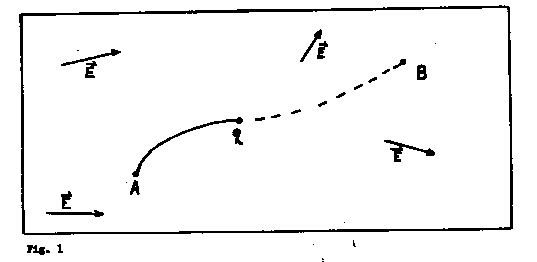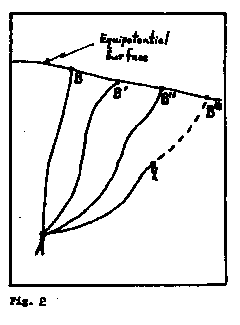Physics 271L Experiment 2
Purpose: To locate experimentally some of the equipotentials in a conducting medium
and to use these equipotentials to determine electric field lines.
Reference: Electrostatic potential, potential difference, electric lines of force,
etc. are discussed in Halliday, Resnick and Krane, Chapters 28 and 30.
Supplies: You should bring white or graph paper, pencils, and a French curve if you
have one.
Theory: Suppose we have a region in which there exists a
static electric field E which may vary in magnitude and direction from point to
point (see Fig. 1). Also suppose we have a charge q initially at rest at point A
and that we somehow "hook on" to q and put it to point B and
leave it at rest there. ( We assume for simplicity that there are no friction forces
and that the region is not in a gravitational field ) Then the electrostatic potential
of point B with respect to point A is defined as the mechanical work done on
q in going from A to B divided by q. In symbols,
(1) 

From elementary mechanics, have the usual expression for the mechanical work:
(2) 
where  is the net mechanical force
at each point and
is the net mechanical force
at each point and  is the
usual line increment.
is the
usual line increment.
Now if q is to start from rest and end at rest there must be no net acceleration.
One way of accomplishing this is to require the net mechanical force to balance the
electrical force at each point along the path, that is 
or
(3) 
The electrical force on a charge q is given by  , so
, so
(4) 
Substituting (4) into (2) and using the fact that q is constant we obtain
(5) 
and finally, using (1),
(6) 
This is the basic equation for electrostatic potential differences. Notice that two points
must be specified in computing VAB ; to say that point B alone
has a certain potential is meaningless. It will also be shown in lecture that for a given
region and electric field VAB depends only on points A and B
and is independent of the path between them.
Equation (6) may also be written in the differential form:  where
where  is the angle between
is the angle between  and
and  . If we define,
. If we define,  the projection of
the projection of  along
along  , then
, then
(7) 
The quantity  , the change in
potential with respect to change in distance along
, the change in
potential with respect to change in distance along  , is called the "directional
derivative".
, is called the "directional
derivative".

Now suppose we replace q at A and pull it along a different path until it
reaches a point B' such that  . If we repeat this procedure many times we will find a set of points B,
B', B'', . . . ., all of which have the same potential with respect to point
A (See Fig. 2). This set of points defines an equipotential surface having the
property that the potential difference between any two points on the surface is zero.
. If we repeat this procedure many times we will find a set of points B,
B', B'', . . . ., all of which have the same potential with respect to point
A (See Fig. 2). This set of points defines an equipotential surface having the
property that the potential difference between any two points on the surface is zero.
This property allows us to derive a relations between the direction of  and the equipotential surface.
We have already shown that
and the equipotential surface.
We have already shown that  , in general. If we stay on an equipotential surface then dV=0
so
, in general. If we stay on an equipotential surface then dV=0
so  .
.
Since  and
and  in general, we must have
in general, we must have  . This occurs only if
. This occurs only if  . In other words
. In other words  is perpendicular to an
equipotential surface.
is perpendicular to an
equipotential surface.
Finally, suppose that for some region a series of equipotential surfaces have been
determined such that the potential difference  between two adjacent surfaces is the same for all surfaces. We have
shown that
between two adjacent surfaces is the same for all surfaces. We have
shown that  , and since
, and since  is a constant then E is
greatest in the area in which
is a constant then E is
greatest in the area in which  z , the spacing between two adjacent surfaces, is least, and vice
versa.
z , the spacing between two adjacent surfaces, is least, and vice
versa.
Apparatus: The region you will inspect is a sheet of
graphite paper so you will be working
in two dimensions instead of three and will be finding equipotential lines instead of
surfaces. The apparatus is shown pictorially and schematically in Figs. 3(a) and 3(b)

Fig3(a)

Fig3(b)
Points A and B are connected by a wire so there is no potential
difference between them. By adjusting the dial of the helipot VAC may
take on any value from zero to VAE , and by pressing the probe to
different points on the graphite paper VBD may take on any value from 0
to VBF ( = VAE since EF and AB
are connected by wires ). If C and D are placed so that there is
potential difference between them (  means that
means that  ) then the galvanometer needle will deflect. In this experiment you
will set VAC to known values and then adjust the probe
position so that no galvanometer deflection is seen, indicating
) then the galvanometer needle will deflect. In this experiment you
will set VAC to known values and then adjust the probe
position so that no galvanometer deflection is seen, indicating  .
.
Procedure
- Assemble a stack of papers as follows: bottom one sheet of white paper; next, one sheet
of carbon (not graphite) paper; next, white; then carbon; and, on top the graphite paper
with silver electrodes (choose the simpler pattern first).
- Place this on the wooden block and press the paper down so that the terminals come up
through the painted electrodes.
- Trace the outline of the electrodes so they will be recorded on the white paper.
- Assemble the apparatus as shown in Fig. 3(a) and 3(b) and have the
instructor check the construction.
- After circuit is okayed, set the helipot dial to 5.00 and plug in the apparatus (Socket
A).
- Holding the probe perpendicular, touch it to the graphite sheet near the center. (Press
fairly firmly; there's a non-conducting paraffin film over the graphite and you must
penetrate this).
- If the galvanometer deflects, move the probe towards one of the electrodes slightly and
note whether the deflection increases of decreases. Keep moving the probe until you get no
deflection. Draw a small circle around this point on the sheet. (When moving the
probe, lift off the paper. If you drag it along the sharp tip will cut the paper and
change the equipotential pattern.)
- Now move the probe ~1/2" - 1" towards one side of the paper and find another
point which gives you a null reading.
- Repeat this until you have a series of points from one side of the paper to the other.
Look for points ~3/8" apart if the line is curving sharply and as you approach the
edge of a conductor or the edge of the paper. Use 1" - 1 1/2" spacing if the
line is not changing direction rapidly.
- Now reset the helipot to 4.00 and repeat the procedure. Continue until you have lines
for helipot settings of 1.00, 2.00, 3.00, 4.00, 5.00, 6.00, 7.00, 8.00, 9.00.
- Remove the stack of papers from the board and have each partner take one of the white
sheets, which should now have a series of dots and circles on them.
- Assemble a new stack of papers using the second graphite sheet for the top. Find
the equipotential lines for this second sheet.
- Remove the papers and unplug the apparatus. Using a French curve, if available, complete
the lines through the points on all your white sheets. Note especially how the
equipotentials lines behave when they are close to conductors.
- To represent electric field lines start from one of the painted electrodes and draw a
series of smooth curves to the other electrode, using the fact that electric field lines
and equipotentials cross at right angles. Determine the direction of the electric field by
observing the polarity of the electrodes. Again, notice how the electric field lines
behave in the neighborhood of conductors and insulators. Also find areas in which the
electric field is strong and those in which it is weak. How are these areas related to
electrode position and shape?
Questions:
- How many equipotential lines can pass through a conductor in a static electric field?
Why?
- Observe your data closely. What is the angle between the edge of the sheet and each
equipotential line as it meets the edge? Can you explain this?
- How do the characteristics of equipotentials in a limited two-dimensional region differ
from those in an infinite three-dimensional region?
- Can you use symmetry arguments to reduce the number of points you must take to determine
equipotentials lines in some of your electrode patterns?
- Observe your data closely. What is the angle between the edge of the conductors or
electrodes and the electric field lines? Can you explain this?



